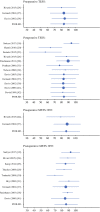Functional Outcome Measurement in Patients with Lower-Extremity Soft Tissue Sarcoma: A Systematic Literature Review
- PMID: 31407171
- PMCID: PMC6863783
- DOI: 10.1245/s10434-019-07698-w
Functional Outcome Measurement in Patients with Lower-Extremity Soft Tissue Sarcoma: A Systematic Literature Review
Abstract
Background: The importance of functional outcome (FO) in the treatment of patients with extremity soft tissue sarcoma (STS) has been increasingly recognized in the last three decades. This systematic review aimed to investigate how FO is measured in surgically treated lower-extremity STS patients.
Methods: A systematic search of PubMed, Web of Science, and Scopus was performed based on the PRISMA guidelines. The methodologic quality of the publications was measured using the MINORS tool. The results from the included studies examining measurement types, measures, and time of FO measurement were compiled. The FO pooled mean and standard deviation were calculated as a weighted average for the groups. The validity of the applied measures is reported.
Results: The literature search found 3461 publications, 37 of which met the inclusion criteria. The measurement types used were clinician-reported outcomes (n = 27), patient-reported outcomes (n = 20), and observer-reported outcomes (n = 2). The most frequently used measures were the Toronto Extremity Salvage Score (TESS) (n = 16) and the Musculoskeletal Tumor Society (MSTS) score 1993 (n = 12). The postoperative FO was relatively good. The pooled mean TESS and MSTS 1993 scores were respectively 83.3 and 86.2 (out of 100). Of the 10 previously reported measures, 3 provide validated FO scores. The methodologic quality of publications was generally low.
Conclusions: Based on this systematic review, several different methods exist for assessing FO in patients with lower-extremity sarcoma. The most frequently used measure is a validated TESS. The postoperative FO of patients with lower-extremity STS seems to increase to the preoperative baseline level during long-term follow-up evaluation.
Conflict of interest statement
There are no conflicts of interest.
Figures
Comment in
-
ASO Author Reflection: Demographic Conditions are the Major Determinants for Functional Outcome and Quality of Life in Lower Extremity Soft Tissue Sarcoma Patients.Ann Surg Oncol. 2021 Oct;28(11):6906-6907. doi: 10.1245/s10434-021-09781-7. Epub 2021 Mar 2. Ann Surg Oncol. 2021. PMID: 33651213 Free PMC article. No abstract available.
References
-
- Davis AM, Bell RS, Badley EM, et al. Evaluating functional outcome in patients with lower extremity sarcoma. Clin Orthop Relat Res. 1999;90–100. - PubMed
-
- Furtado S, Errington L, Godfrey A, et al. Objective clinical measurement of physical functioning after treatment for lower extremity sarcoma: a systematic review. Eur J Surg Oncol. 2017;43:968–993. - PubMed
-
- Davis AM. Functional outcome in extremity soft tissue sarcoma. Semin Radiat Oncol. 1999;9:360–368. - PubMed
-
- MacDermid JC, Grewal R, MacIntyre NJ. Using an evidence-based approach to measure outcomes in clinical practice. Hand Clin. 2009;25(97–111):vii. - PubMed
Publication types
MeSH terms
LinkOut - more resources
Full Text Sources
Medical
Miscellaneous



